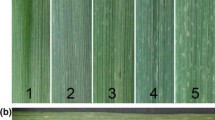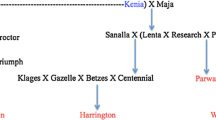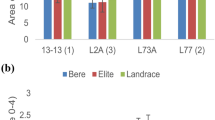Abstract
The genetic basis of resistance to Rhynchosporium commune was investigated in a winter barley mapping population derived from a cross between cultivars Saffron (moderately susceptible) and Retriever (moderately resistant). Resistance was assessed in field trials through total infection (measured using qPCR), and visible disease symptoms. Phenotypic correlations between both methods of assessing disease severity were high. QTL mapping from three years of field trials identified five significant QTL effects. One QTL effect on chromosome 2H confirms a previously reported resistance from a population derived from the spring cultivar Cocktail and a winter parent derived from the cultivars Pearl and Cocktail. Another QTL effect on 3H corresponds to the reported position of major resistance gene Rrs1. An effect was detected at the mapped position of the semi-dwarfing gene sdw-1 despite the fact that neither parent has the semi-dwarf phenotype. Of the remaining two QTL effects, one on 6H may represent a previously reported rhynchosporium resistance (QTLTritonRrs6H271), whilst the final QTL, represents a novel resistance. In addition, interactions during early infection stages in the parental lines were studied by confocal microscopy of detached leaves inoculated with a GFP-expressing R. commune isolate. This approach identified a number of major differences in fungal growth morphology between the resistant and susceptible parent.



Similar content being viewed by others
References
Abang MM, Baum M, Ceccarelli S, Grando S, Linde CC, Yahyaoui AH, Zhan J, McDonald BA (2006) Pathogen evolution in response to host resistance genes: evidence from fields experiments with Rhynchosporium secalis on barley. Phytopathology 96(6):S2–S2
Abbott DC, Brown AHD, Burdon JJ (1992) Genes for scald resistance from wild barley (hordeum-vulgare ssp spontaneum) and their linkage to isozyme markers. Euphytica 61(3):225–231
Bearchell SJ, Fraaije BA, Shaw MW, Fitt BD (2005) Wheat archive links long-term fungal pathogen population dynamics to air pollution. Proc Natl Acad Sci USA 102(15):5438–5442
Bjornstad A, Patil V, Tekauz A, Maroy AG, Skinnes H, Jensen A, Magnus H, Mackey J (2002) Resistance to scald (Rhynchosporium secalis) in barley (Hordeum vulgare) studied by near-isogenic lines: i. Markers differ isol. Phytopathol 92(7):710–720
Boer MP, Wright D, Feng LZ, Podlich DW, Luo L, Cooper M, van Eeuwijk FA (2007) A mixed-model quantitative trait loci (QTL) analysis for multiple-environment trial data using environmental covariables for QTL-by-environment interactions, with an example in maize. Genetics 177(3):1801–1813
Close T, Bhat P, Lonardi S, Wu Y, Rostoks N, Ramsay L, Druka A, Stein N, Svensson J, Wanamaker S, Bozdag S, Roose M, Moscou M, Chao S, Varshney R, Szucs P, Sato K, Hayes P, Matthews D, Kleinhofs A, Muehlbauer G, DeYoung J, Marshall D, Madishetty K, Fenton R, Condamine P, Graner A, Waugh R (2009) Development and implementation of high-throughput SNP genotyping in barley. BMC Genomics 10(1):582. doi:10.1186/1471-2164-10-582
Comadran J, Kilian B, Russell J, Ramsay L, Stein N, Ganal M, Shaw P, Bayer M, Thomas W, Marshall D, Hedley P, Tondelli A, Pecchioni N, Francia E, Korzun V, Walther A, Waugh R (2012) Natural variation in a homolog of antirrhinum centroradialis contributed to spring growth habit and environmental adaptation in cultivated barley. Nat Genet 44(12):1388–1392
Fountaine JA, Shaw MW, Napier B, Ward E, Fraaije BA (2007) Application of real-time and multiplex polymerase chain reaction assays to study leaf blotch epidemics in barley. Phytopathology 97(3):297–303
Graner A, Tekauz A (1996) RFLP mapping in barely of a dominant gene conferring resistance to scald (Rhynchosporium secalis). Theor Appl Genet 93(3):421–425. doi:10.1007/bf00223185
Hofmann K, Silvar C, Casas A, Herz M, Büttner B, Gracia MP, Contreras-Moreira B, Wallwork H, Igartua E, Schweizer G (2013) Fine mapping of the Rrs1 resistance locus against scald in two large populations derived from spanish barley landraces. Theor Appl Genet 126(12):1019–1128
International V (2011) Genstat for windows, 14th edn. VSN International, Hemel Hempstead
Jones ERL, Newton AC (2004) UKCPVS 2004 Report: Rhynchosporium on barley
Karperien A (2012) FracLac for ImageJ, version 2.5. http://rsb.info.nih.gov/ij/plugins/fraclac/FLHelp/Introduction.htm. Accessed 10 Dec 2012
Lehnackers H, Knogge W (1990) Cytological studies on the infection of barley cultivars with known resistance genotypes by Rhynchosporium secalis. Can J Bot-Rev Can De Bot 68:1953–1961
Li CH, Tam PKS (1998) An iterative algorithm for minimum cross entropy thresholding. Pattern Recogn Lett 19(8):771–776
Looseley ME, Newton AC, Atkins SD, Fitt BD, Fraaije BA, Thomas WTB, Keith R, Macaulay M, Harrap D, Thirugnanasambandam A (2012a) Genetic control of infection and symptom expression by Rhynchosporium commune in barley. Proc Crop Prot North Br 2012:133–137
Looseley ME, Newton AC, Atkins SD, Fitt BDL, Fraaije BA, Thomas WTB, Keith R, Macaulay M, Lynott J, Harrap D (2012b) Genetic basis of control of Rhynchosporium secalis infection and symptom expression in barley. Euphytica 184(1):47–56
Malosetti M, van Eeuwijk FA, Boer MP, Casas AM, Elia M, Moralejo M, Bhat PR, Ramsay L, Molina-Cano JL (2011) Gene and QTL detection in a three-way barley cross under selection by a mixed model with kinship information using SNPs. Theor Appl Genet 122(8):1605–1616. doi:10.1007/s00122-011-1558-z
Moragues M, Comadran J, Waugh R, Milne I, Flavell AJ, Russell JR (2010) Effects of ascertainment bias and marker number on estimations of barley diversity from high-throughput SNP genotype data. Theor Appl Genet 120(8):1525–1534. doi:10.1007/s00122-010-1273-1
Newton A, Guy D (1998) Exploration and exploitation strategies of powdery mildew on barley cultivars with different levels of nutrients. Eur Plant Pathol 104(8):829–833
Newton AC, Hackett CA (1994) Subjective components of mildew assessment on spring barley. Eur Plant Pathol 100(6):395–412. doi:10.1007/BF01874807
Newton AC, Searle J, Guy DC, Hackett CA, Cooke DEL (2001) Variability in pathotype, aggressiveness, RAPD profile, and rDNA ITS1 sequences of UK isolates of Rhynchosporium secalis. Zeitschrift fur Pflanzenkrankh und Pflanzenschutz-J Plant Dis Prot 108(5):446–458
Newton AC, Meyer RC, Young GR, Lawrence PE, Russell JR, Booth A, Ramsay L, Webster RK, Steffenson BJ, Thomas WTB (2004) Disease resistance mapping in spring barley. In: Proceedings of the 9th international barley genetics symposium., 20–26 Jun 2004, pp 720–725
Newton AC, Swanston JS, Guy DC (2004) Enhanced durability and utility of genes for resistance by deployment in cultivar mixtures. In: Proceedings molecular plant–microbe interactions XI, 18–26 July 2003, St Petersburg, pp 240–243
Newton AC, Fitt BD, Atkins SD, Walters DR, Daniell TJ (2010) Pathogenesis, parasitism and mutualism in the trophic space of microbe-plant interactions. Trends Microbiol 18(8):365–373. doi:10.1016/j.tim.2010.06.002
Saville RJ, Gosman N, Burt CJ, Makepeace J, Steed A, Corbitt M, Chandler E, Brown JKM, Boulton MI, Nicholson P (2012) The ‘Green Revolution’ dwarfing genes play a role in disease resistance in Triticum aestivum and Hordeum vulgare. J Exp Bot 63(3):1271–1283. doi:10.1093/Jxb/Err350
Schneider CA, Rasband WS, Eliceiri KW (2012) NIH image to imagej: 25 years of image analysis. Nat Methods 9(7):671–675
Thirugnanasambandam A, Wright KM, Atkins SD, Whisson SC, Newton AC (2011) Infection of Rrs1 barley by an incompatible race of the fungus Rhynchosporium secalis expressing the green fluorescent protein. Plant Pathol 60(3):513–521. doi:10.1111/j.1365-3059.2010.02393.x
Van Ooijen JW (2006) JoinMap 4 software for the calculation of genetic linkage maps in experimental populations of diploid species. Kyazma B.V., Wageningen
Wagner C, Schweizer G, Kramer M, Dehmer-Badani AG, Ordon F, Friedt W (2008) The complex quantitative barley-Rhynchosporium secalis interaction: newly identified QTL may represent already known resistance genes. Theor Appl Genet 118(1):113–122. doi:10.1007/s00122-008-0881-5
Walters DR, Avrova A, Bingham IJ, Burnett FJ, Fountaine J, Havis ND, Hoad SP, Hughes G, Looseley M, Oxley SJP, Renwick A, Topp CFE, Newton AC (2012) Control of foliar diseases in barley: towards an integrated approach. Eur J Plant Pathol 133(1):33–73
Xi K, Xue AG, Burnett PA, Helm JH, Turkington TK (2000) Quantitative resistance of barley cultivars to Rhynchosporium secalis. Can j Plant Pathol 22(3):217–223
Zaffarano PL, McDonald BA, Zala M, Linde CC (2006) Global hierarchical gene diversity analysis suggests the fertile crescent is not the center of origin of the barley scald pathogen Rhynchosporium secalis. Phytopathology 96(9):941–950
Zhan J, Fitt BDL, Pinnschmidt HO, Oxley SJP, Newton AC (2008) Resistance, epidemiology and sustainable management of Rhynchosporium secalis populations on barley. Plant Pathol 57(1):1–14
Acknowledgments
The authors would like to thank the Scottish Government’s Rural and Environmental Science and Analytical Services (RESAS), and the Technology Strategy Board (TSB) for funding this research. Thanks are also due to Professor Bruce Fitt, for his contributions to the planning of the project from which these results are taken, and to the estate staff at the James Hutton Institute.
Author information
Authors and Affiliations
Corresponding author
Electronic supplementary material
Below is the link to the electronic supplementary material.
Rights and permissions
About this article
Cite this article
Looseley, M.E., Keith, R., Guy, D. et al. Genetic mapping of resistance to Rhynchosporium commune and characterisation of early infection in a winter barley mapping population. Euphytica 203, 337–347 (2015). https://doi.org/10.1007/s10681-014-1274-2
Received:
Accepted:
Published:
Issue Date:
DOI: https://doi.org/10.1007/s10681-014-1274-2




